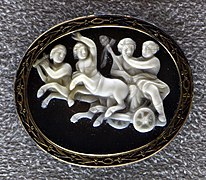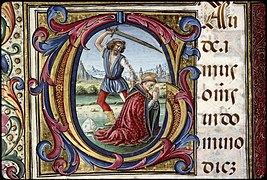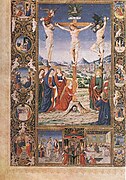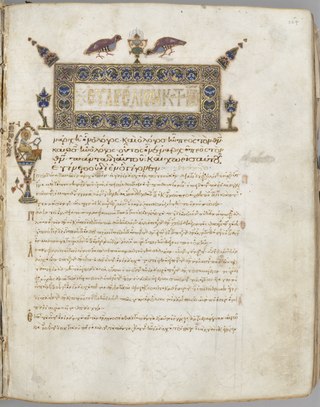
An illuminated manuscript is a formally prepared document where the text is decorated with flourishes such as borders and miniature illustrations. Often used in the Roman Catholic Church for prayers and liturgical books such as psalters and courtly literature, the practice continued into secular texts from the 13th century onward and typically include proclamations, enrolled bills, laws, charters, inventories, and deeds.

The Vespasian Psalter is an Anglo-Saxon illuminated psalter decorated in a partly Insular style produced in the second or third quarter of the 8th century. It contains an interlinear gloss in Old English which is the oldest extant English translation of any portion of the Bible. It was produced in southern England, perhaps in St. Augustine's Abbey or Christ Church, Canterbury or Minster-in-Thanet, and is the earliest illuminated manuscript produced in "Southumbria" to survive.

In a written or published work, an initial is a letter at the beginning of a word, a chapter, or a paragraph that is larger than the rest of the text. The word is derived from the Latin initialis, which means standing at the beginning. An initial is often several lines in height and in older books or manuscripts are known as "inhabited" initials. Certain important initials, such as the Beatus initial or "B" of Beatus vir... at the opening of Psalm 1 at the start of a vulgate Latin. These specific initials in an illuminated manuscript were also called initiums.

The Fécamp Bible is an illuminated Latin Bible. It was produced in Paris during the third quarter of the 13th century, and had previously belonged in the collection of Henry Yates Thompson.

Dol-de-Bretagne Cathedral is a Roman Catholic church located in Dol-de-Bretagne. The cathedral is dedicated to Saint Samson, one of the founding saints of Brittany. It was formerly the seat of the Archbishop of Dol, one of the nine ancient bishoprics of Brittany. The cathedral suffered badly from the excesses of the French Revolution, becoming successively a "Temple de la Raison", then a stable, then a warehouse. Revolutionaries caused considerable damage and many treasures were lost. When it eventually returned to being a house of worship, its role as a bishopric was abolished by the Concordat of 1801 when the Dol diocese was merged into the Dioceses of Rennes and Saint-Malo. The Concordat of 1801 was an agreement between Napoleon and Pope Pius VII, signed on 15 July 1801 in Paris, which sought national reconciliation between revolutionaries and Catholics. The Concordat was abrogated by the law of 1905 on the separation of church and state.

Niccolò di Ser Sozzo was an Italian painter and manuscript illuminator. He generally has been identified as Niccolò di Ser Sozzo di Francesco Tegliacci, but recent research points instead to a Niccolò di Ser Sozzo di Stefano. Whatever his true identity, Niccolo was one of the leading panel painters and miniaturists at work in Siena in the mid-14th century. His style is closest to that of Lippo Vanni and his sometime collaborator Luca di Tomme and is ultimately dependent upon the tradition of Simone Martini and, especially, the Lorenzetti brothers, in whose workshop he may have apprenticed.

The Turin–Milan Hours is a partially destroyed illuminated manuscript, which despite its name is not strictly a book of hours. It is of exceptional quality and importance, with a very complicated history both during and after its production. It contains several miniatures of about 1420 attributed to an artist known as "Hand G" who was probably either Jan van Eyck, his brother Hubert van Eyck, or an artist very closely associated with them. About a decade or so later Barthélemy d'Eyck may have worked on some miniatures. Of the several portions of the book, that kept in Turin was destroyed in a fire in 1904, though black-and-white photographs exist.
Reginald of Bar was bishop of Metz from 1302.

Attavante degli Attavanti was an Italian painter.
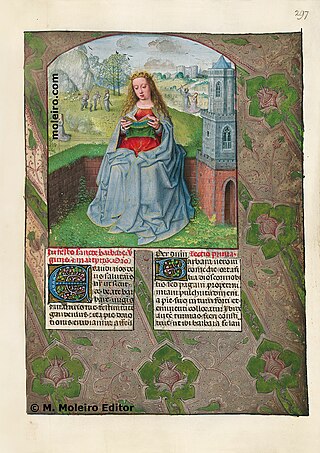
The Isabella Breviary is a late 15th-century illuminated manuscript housed in the British Library, London. Queen Isabella I of Castile was given the manuscript shortly before 1497 by her ambassador Francisco de Rojas to commemorate the double marriage of her children and the children of Emperor Maximilian of Austria and Duchess Mary of Burgundy.

The Howard Psalter and Hours is a 14th-century illuminated prayerbook. It includes a liturgical Psalter with canticles and litany, the Office of the Dead, a calendar of East Anglian origin and an incomplete Hours of the Passion. It was produced between 1310 and 1320. It is written in Latin in a Gothic script in two columns per page. There are 115 extant folios which measure 360 by 235 mm. The text block occupies an area of 250 by 166 mm. It is bound together with the De Lisle Psalter, a contemporary psalter.

The Hours of James IV of Scotland, Prayer book of James IV and Queen Margaret is an illuminated book of hours, produced in 1503 or later, probably in Ghent. It marks a highpoint of the late 15th century Ghent-Bruges school of illumination and is now in the Austrian National Library in Vienna. It is thought to have been a wedding gift from James IV of Scotland or another Scottish nobleman to James's wife Margaret Tudor on the occasion of their marriage, perhaps finishing a book already started for another purpose. A number of artists worked on the extensive programme of decoration, so that "the manuscript in its entirety presents a rather odd picture of heterogeneity". The best known miniature, a full-page portrait of James at prayer before an altar with an altarpiece of Christ and an altar frontal with James's coat-of-arms, gave his name to the Master of James IV of Scotland, who is now generally identified as Gerard Horenbout, court painter to Margaret of Austria; he did only one other miniature in the book. The equivalent image of Margaret is the only image by another artist, using a rather generic face for the queen's portrait, and in a similar style to that of the Master of the First Prayer Book of Maximilian. Other artists worked on the other miniatures, which include an unusual series of unpopulated landscapes in the calendar – perhaps the Flemish artists were not sure how Scots should be dressed.

The Book of Hours of Simon de Varie is a French illuminated manuscript book of hours commissioned by the court official Simon de Varie, with miniatures attributed to at least four artists; hand A who may have been a workshop member of the Bedford Master, the anonymous illustrators known as the Master of Jean Rolin II, the Dunois Master and the French miniaturist Jean Fouquet. It was completed in 1455 and consists of 49 large miniatures and dozens of decorative vignettes and painted initials, which total over 80 decorations. Fouquet is known to have contributed six full leaf illuminations, including a masterwork Donor and Virgin diptych. A number of saints appear - Saint Simon is placed as usual alongside Saint Jude ; other pages feature saints Bernard of Menthon, James the Greater and Guillaume de Bourges.

Insular illumination refers to the production of illuminated manuscripts in the monasteries of Ireland and Great Britain between the 6th and 9th centuries, as well as in monasteries under their influence on continental Europe. It is characterised by decoration strongly influenced by metalwork, the constant use of interlacing, and the importance assigned to calligraphy. The most celebrated books of this sort are largely gospel books. Around sixty manuscripts are known from this period.

The Missal of the Academy of Sciences is a notable Portuguese 17th-century Roman Pontifical codex, profusely illuminated by Estêvão Gonçalves Neto.
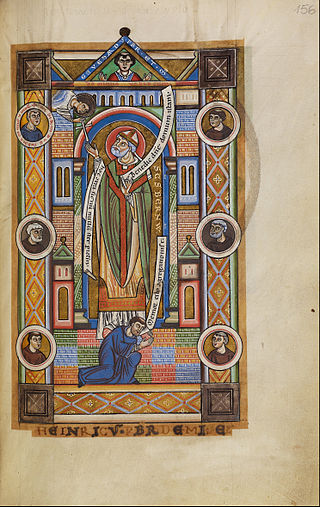
The Stammheim Missal is an illuminated manuscript Roman missal made between 1160 and 1170. It is now in the J. Paul Getty Museum, having been acquired from the private collection of the barons of Fürstenberg, who sold it to raise funds to repair Schloss Körtlinghausen. A Carolingian ivory diptych had been used for its binding, but was removed in 1904 and was in the State Museums of Berlin until 1945, when it disappeared during the bombing of Berlin in World War II.
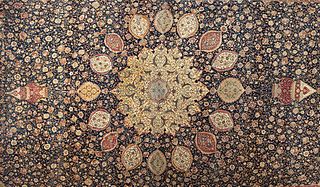
In Islamic art, a shamsa is an intricately decorated rosette or medallion which is used in many contexts, including manuscripts, carpets, ornamental metalwork and architectural decoration such as the underside of domes. It can take a number of overall shapes, from circles to stars. The name means "little sun", as a diminutive of shams, the Arabic word meaning "sun", and the work is often stylised as a sunburst. It is characterized by the recurrent motifs present in Islamic art, such as the use of geometrical floral or vegetal forms in a repetitive design known as an arabesque. The arabesque is often used to symbolize the transcendent, indivisible and infinite nature of God, and as with other patterns and forms of Islamic art, the shamsa also has a religious significance, such as symbolizing the unity of God.
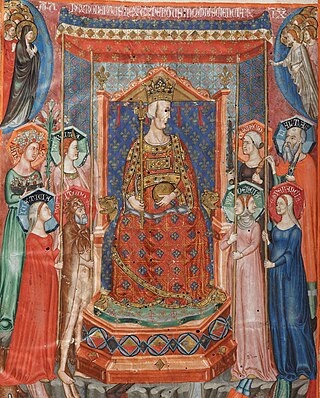
The Anjou Bible, or Bible Angevine, is an illustrated manuscript created c. 1340 in the court of King Robert I of Naples and Sicily. The Bible consists of 344 folios with two full-page illustrations and over 80 small miniatures, dated initials, and marginal miniatures. The work is considered a masterpiece of Italian literature from the fourteenth century.

The Bible of Federico da Montefeltro or Bibbia Urbinate is an illuminated manuscript containing the Vulgate text. It was commissioned by Federico III da Montefeltro and produced in Florence between 1476 and 1478. Now, it is housed in the Vatican Apostolic Library.
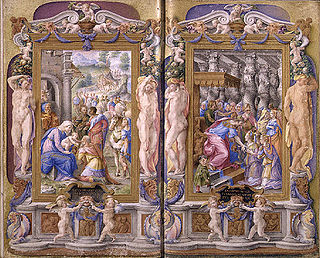
Renaissance illumination refers to the production of illuminated manuscripts in Western Europe in the late 15th and 16th centuries, influenced by the representational techniques and motifs of Renaissance painting. With the invention of printing, book painting did not disappear abruptly, but continued in certain luxury manuscripts, and even in some printed works. Illuminators of the period used techniques of perspective representation and iconographic themes specific to the period. Restricted to luxury works, this type of production declined in the second half of the 16th century, as engraving became increasingly competitive.





